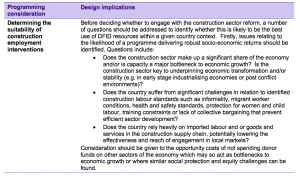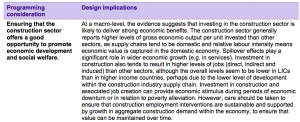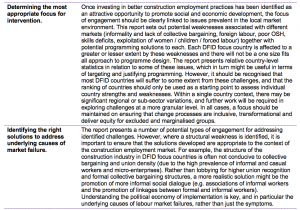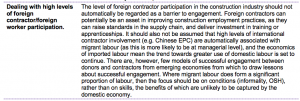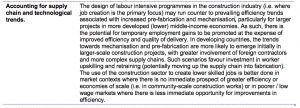This note summarises key findings on the value of investing in strengthening the construction industry and creating / improving the quality of jobs in the construction industry, and presents related programming considerations. It is based on a report, commissioned through ICED, that seeks to explore opportunities for, and barriers to, the construction industry as a source of productive and decent job creation in LICs.
The report finds that support for the construction sector can provide significant benefits in terms of economic and employment effects, and potentially greater than those available in other sectors. A recent study estimated total economic multipliers in high- and middle-income countries to be greater than 3:1, based on direct, indirect and induced economic outputs (ILO 2015e). In the same study, employment creation was estimated at 158 jobs per million US dollars invested in a sample of middle income countries.
Core economic value derives from the development, renovation, repair or extension of fixed assets (buildings, land improvements, engineering assets). However, the construction sector also has significant backward and forward linkages. Supply chain benefits can include the development of input industries, including cement, steel, paints and chemicals, glass, timber and machinery, alongside construction services, planning and design, finance, enforcement. The construction sector also has forward linkages, underpinning economic development in other sectors, including transport, housing, power, water, waste and telecommunications.
Within the construction sector, there are also potentially significant economic benefits associated with construction employment reform (addressing informality, health and safety standards, female and child participation, issues around capacity and collective bargaining). These can hinder effective sector development and impose high social welfare costs on governments and wider society. Addressing them can also improve the economic efficiency of the delivery model itself.
When designing programmes, care should be taken to ensure that the construction sector and associated employment issues are a) significant within the country context (i.e. well evidenced); and b) significant in relation to other sectors (i.e. there is no opportunity cost associated with intervention). Efforts should be made to understand whether the construction sector supply chain is dominated by import-based (labour or materials), as this may reduce the efficacy of sector interventions or require different types of programming.
Costs and benefits can be identified through standard cost benefit analysis (CBA) undertaken as part of a business case development process. Key benefit drivers might include avoided loss of life and injury, increased productivity (e.g. from improved training or greater inclusion), and enhanced job creation in the supply chain. However, there is very limited evidence in the literature of formal cost benefit analysis having been undertaken on construction sector employment reform programmes to date.
Maximising value for money in construction and associated employment interventions is highly dependent on the quality of programme design and delivery. Interventions should be evidence-based, clearly aligned with market weaknesses, and where possible integrated into a holistic programme of sector reform. Interventions should also be sensitive to market and political economy realities (e.g. around collective bargaining or female participation).
There may be resistance to change due to concerns around the social and economic costs of migrating from established sector models. Scale up of reform is most successful when it builds upon successful demonstration models and consultation processes that help secure buy-in from public and private authorities. Programmes are also successful when integrated as a sub-component into sector investment and reform programmes (e.g. housing, transport).
Consideration should be given to emerging labour market and technology changes in the construction sector (e.g. moves towards automation, pre-fabrication), which have the potential to improve the efficiency but also potentially change or reduce the nature of labour force participation. Labour intensity during construction may therefore reduce over time, but be displaced into supply chains and manufacturing. This may determine the focus of an intervention (e.g. engaging with upstream supply chains). Figure 1, on the next page, sets out some of the questions that should be considered during the design and delivery of construction employment programmes.
Figure 1: Decision framework for engaging with construction employment reform
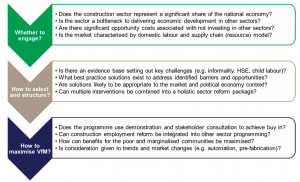
Overall, the report concludes that intervening in the construction sector (both to increase the number and quality of construction sector jobs) is likely to provide value for money for UK Aid, but that this value is dependent on addressing challenges in their local context and ensuring effective programme design. Ultimately, the decision to support construction labour reform will depend on a strong understanding of the economic, regulatory, and commercial environment and upon a robust approach to design. Table 1 provides an overview of key lessons and principles.
Table 1: VfM principles for Construction Sector technical assistance programming: Improving chances of successful delivery
